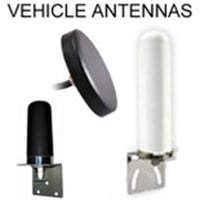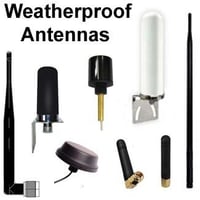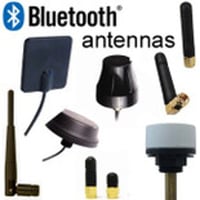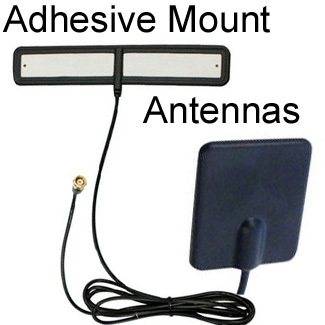412-440MHz Antennas
433MHz Frequency Band 412-440 MHz
The 412-440 MHz frequency spectrum falls around the ISM band of 433.050 MHz to 434.790 MH for low power devices (LPD433). The band is differently allocated and licensed in different regions. In most European countries under CEPT administration, 433 MHz is free to use on short-range, low power devices with varying legal specifications. For some countries in Asia and North America, use of 433 MHz spectrum is restricted to government and RFID devices.
Local administrative laws and RF governing body set different regulations regarding the nature of use of the RF frequency 433 MHz. where allowed, this frequency band has a common restriction on the range and use. The range is limited to 100 meters and a transmission of 30 seconds every 10 seconds.
This band of frequencies is popular in wireless remote controls and IoT (Internet of Things) devices. This frequency is favored for its low power consumption, and cheaper assembly components compared to alternative higher frequency ISM bands.
Common applications include:
- IoT (Internet of Things)
- Wireless instruments
- Remote control devices
- RFID devices
- Amateur radio
- Amateur satellites
- Government radar devices
The 433 MHz frequency band
The 433 MHz frequency band is an unlicensed frequency band that spans 433.05 MHz to 434.79 MHz. The range of frequency between 412-440 MHz is typically allocated to amateur radio and amateur satellites in non-restricted regions. The range of the spectrum and user restrictions vary considerably in different regions.
In certain geographic regions (Region 1 according to the International Telecommunications Union) it is designated an Industrial Scientific and Medical band. In the United States, the use of this band is restricted as it falls within the 70-centimeter band (420 MHz to 450 MHz) which is used for licensed amateur (Ham) radio and governmental use. This ultra-high frequency (UHF) band is also described as the Low Power Device 433 (LPD433) band for license-free voice radio communications. This means that the applications for which a 433 MHz antenna is required are diverse, as discussed below.
The 433 MHz ISM band are preferred for long-distance, low power wireless connectivity.
- Long-distance
As a UHF frequency, 433 MHz signal propagation is predominantly by line of sight, with some ground reflection. With clear and unobstructed exposure of the communicating antennas, transmission distances of tens kilometers can be achieved, with further distances possible if repeaters are used. Physical structures like hills and tall buildings will impede 433 MHz frequencies, but they are able to penetrate walls and provide indoor reception.
- Low energy
Radio propagation at the 433 MHz frequency has low energy consumption. Its free space path loss is significantly less than the losses at higher frequencies (e.g. 2.4 GHz). Therefore with identical output power and sensitivity of the receiver, greater ranges can be achieved at 433 MHz than higher frequencies.
This sub 1 GHz band is also advantageous because fewer propagation problems and less interference mean that less battery life is used up in acquiring or maintaining a signal. This makes 433 MHz an ideal candidate frequency band for alternative Low Power Wireless Area Networking and single or multi-hop communications.
433 MHz antennas for LP-WANS>
Low Power Networks also known as Low Power Wide Area Networks are networks that rely on battery-powered radio communication across large distances. The antennas or sensors that participate in the network use low bitrate data transfer, no more than 50 kbps in the most sophisticated of these networks. These simply engineered networks are utilized for a variety of applications because of their low energy consumption, ease of maintenance, and low cost. They are also very scalable meaning initial deployments can be rapidly expanded where necessary. A number of proprietary networking standards specify for this form of networking in the 433 MHz frequency band including:
- LoRa stands for Long Range and is an LP-WAN protocol that was originally developed in France, using Chirp Spread Spectrum (CSS) modulation as its foundation. Using the 433 MHz frequency band, this standard provides physical layer specifications for a network capable of transmitting over 10 kilometers (6.21 miles). Geolocation can also be integrated with this technology and it can sustain consistent data rates of 27 kbps. It can be deployed with various network and MAC layer protocols, typically LoRaWAN, though they are not explicitly specified by the LoRa standard. The LoRa Alliance which comprises over 500 participants including IBM and Cisco, oversee developments in the protocol and ensure interoperability amongst compliant devices.
- SigFox is a French company that develops low powered star topology networks for devices like utility meters that need to be continually powered. Their wireless networking standard uses differential binary phase-shift keying (DBPSK) and the Gaussian frequency-shift keying (GFSK) with bitrates of up to 100 kbps. SigFox can take advantage of the 433 MHz frequency band in regions where it is legally available. The narrow-band signal used is low energy and has good penetration of walls and can even reach underground objects.
- The Dash7 Alliance Protocol is an open-source wireless networking standard that networks wireless sensors and actuators. Originally a defense-related protocol, Dash7 has evolved to support a range of sensor-based applications including access control and building automation. Under optimal conditions, this protocol can achieve multi-year battery life and cover distances of up to 2 kilometers (1.2 miles). Data transfer rates of 167 kbps are achieved in short bursts which can also be encrypted. It can be used at all the sub 1 GHz ISM bands and can be deployed globally with low infrastructure requirements and cost.
- Weightless is a highly scalable LP-WAN protocol that can operate effectively at 433 MHz. Weightless' open source wireless networking standard provides specifications for bi-directional communication between networked devices and central controllers using narrowband channels of just 12.5 kHz. Weightless uses a variety of modulation techniques to support data transfer rates of up to 100kbps. It also is low energy with a transmit power of 14dB maximum to allow networked devices to be powered by coin cell batteries.
433 MHz antennas for IEEE 802.15.4f
433 MHz antennas are key to networking in accordance with the 802.15.4 standard for cost-effective, low energy networking produced by the Institute of Electrical and Electronics Engineers. 802.15.4 is specifically focused on battery-powered remote sensors that may be deployed for years at a time without human intervention. The protocol deals with the MAC and PHY layers of the network, allowing branded, proprietary standards to be developed for the upper layer by companies like ZigBee.
The 802.15.4f version covers compliant wireless communication at 433 MHz. Networking can be on the basis of a star or peer-to-peer topology with communications either between nodes or a central controller. Nodes may be fully functional and capable of sending and receiving data or be reduced function child devices that are more sensor-like. All 802.15.4 networks will have a coordinating or controlling device that manages the network via networked 433 MHz antennas. The communications range specified by this technology is 10 meters (33 feet) but it is extended by scalable mesh networking. Data transfer rates of up to 250 kbps are possible.
Key Applications that use the 433 MHz Frequency
- 433 MHz antenna for IoT
The Internet of Things involved the networking, connectivity, and communication of objects, often with little to no human intervention. IP-addressed sensor or actuator items are able to transmit information about their location or status and potentially affect automated responses. IoT projects involve LP-WAN networking on a variety of levels from smart appliances and domestic environments to regional or national infrastructures like transport or utility systems. One of the big limitations in creating smart homes, smart cities, and the theoretical Internet of Everything (IoE), is the energy consumption required to support such networking. LP-WANs that operate at lower frequencies like the 433 MHz band are seen as advantageous due to the coverage and penetration that can be achieved and the low energy costs involved. By deliberately keeping data rates low battery consumption is minimized and networks can be spread over long distances.
In the US, the use of the 433 MHz frequency band is closely regulated by the FCC under Regulation 10CFR47 Part 15.231. This frequency band is intended for remote control and alternate uses are restricted, with transmission durations limited to only seconds or milliseconds. The transmitter power output is also capped. This means that US based IoT applications will need to ensure that they operate in a compliant manner.
- 433 MHz antenna for M2M
Machine 2 Machine (M2M) communication and connectivity can be supported by this sub 1 GHz band in preference to the 2.4 GHz band which is often overloaded. Dash7 and 802.15.4f are viable contenders for a protocol that will facilitate both indoor and outdoor weatherproof M2M networking at 433 MHz, which is harmonized in Europe and Asia. In industrial settings, the automated wireless movement of sensor data can be used for automatic adjustments in temperature, pressure, speed, and environmental conditions. It has the scope for both practical and innovative applications in sectors such as agriculture, oil, and gas, energy, warehousing, and logistics. Originally, M2M networking was reliant on cellular or wired connections, but wireless connectivity at a low frequency can facilitate low energy machine networking between larger numbers of machines and over greater distances.
- 433 MHz antennas for amateur/Ham radio
The 70-centimeter band spans 430 MHz to 440 MHz (420 to 450 MHz in the US) and is used around the world for amateur radio, satellite, and even television (Fast Scan Television) broadcasting. Equipment for optimal and compliant use of this frequency is readily obtained and components can even be purpose-built by enthusiasts.
This frequency band can be used by amateurs for:
- Frequency Modulation (FM)
- Digital Voice (DV) messaging
- Longer distance Narrowband communications.
- Morse (CW)
- Telephony (SSB)
- Machine Generated Modes (MGM)
- Slow Scan Television (SSTV)
- DX
- Moonbounce
- Internet voice gateways
- Amateur Satellite Service
There are often power and location restrictions in place for users. For example, in the UK, equipment may not be used within a 100 kilometer (62 miles) radius of Charing Cross, at the heart of London. This prevents potential interference from high gain antennas. Some regulators and amateur groups utilize band planning and separate out different frequencies for particular kinds of traffic (e.g. Narrowband or Fast Scan Television).
- Wireless remote controls operating at 433 MHz
The 433 MHz frequency band is internationally allocated for remote control transmission and this is one of the most common applications that use this frequency. The short-range radio communications needed for:
- garage door openers,
- remotely controlled blinds,
- wireless switches,
- domestic sensors,
- and wireless alarms are adequately transmitted at select frequencies within the 70-centimeter band. 433 MHz transceiver and receiver modules are cheap (some less than a dollar depending on quantities ordered) and can be integrated into compact microcontroller units and key fobs that are installed where needed. To boost signal coverage 433 MHz external antennas and 433 MHz signal repeaters can be used to extend the signal from a wireless transmitter.
Types of 433 MHz antenna
Because the wavelength of 433 MHz is longer than, for example, the wavelength at 2.4 GHz, the range of 433 MHz antenna designs may be slightly more limited than expected. Antenna gain is limited for transmissions due to FCC regulations as discussed above which can limit the range that is achievable. Distances are usually around 100 to 300 feet in an outdoor environment and 30 to 100 feet indoors. The type of radio frequency connector fitted to the antenna should also be noted as they can vary widely. Common connectors used on these antennas include SMA, RP-SMA, and TNC. Here are the most commonly available types:
[A] quarter-wave helical antenna
This type of 433 MHz Helical antenna gets the size of the antenna down to workable dimensions. The antenna element is helically coiled to condense its size to around 7.5 centimeters. Further adjustment in pitch and the density of the coiling produces a stub antenna which is favored for its small size ( approx. 5 centimeters).
[B] 433 MHz whip antenna
¼ wave whip antennas provide better performance and bandwidth availability but are longer than helical antennas. Their 170-millimeter length is usually covered with a plastic radome and skirt. They are very flexible and can withstand knocks.
[C] 433 MHz Yagi antenna
This directional 433 MHz antenna can achieve high gains, especially if it carries multiple powered elements. A 433 MHz Yagi is comparable to a television antenna in size and mounting. They are designed for outdoor deployments with attached cabling to the power source and radio device.
[D] 433 MHz panel antenna
Panel antennas are another type of directional antenna that can be used to provide coverage in a specific direction. The gain that can be achieved with this antenna is less than with the Yagi.
The dipole element is concealed behind a flat panel reflector, that can be readily wall mounted.
[E] Omnidirectional 433 MHz antennas
High gain Omni antennas are long, pole-like antennas that maybe half, full or double the wavelength at 433 MHz ( around 70 cm). They are usually mounted at height. They are much lower gain than the directional antennas.
[F] Through-hole mount 433 MHz antennas
Puck antennas, named after their hockey-puck shape, provide presentable and secure through-hole mounting on vehicle roofs, walls, or ceilings and provide omnidirectional coverage. This discrete, low profile antenna design is omnidirectional and tends to be low gain. It can readily be installed in a variety of settings. A pigtail cable with antenna connectors is provided to facilitate downstream connections.
Frequently asked questions
What kind of 433 MHz antennas and cables should an amateur radio enthusiast use?
To get optimal results with Ham radio communications within the 70-centimeter band, the type and quality of equipment make all the difference. Small antennas are less powerful and sensitive, especially when paired with long lengths of 'lossy' thin coax.
The larger, full wavelength or double wavelength antennas are popular with experienced amateur radio users. Omnidirectional antennas are preferable especially if communications are kept local. A 433 MHz vertical co-linear antenna is a suitable choice. For longer distances, directivity is vital and Yagi antennas are preferable. The quality of the attached antenna cable and connectors is also key and signal attenuation should be kept to an absolute minimum. Thicker diameter coax (>10mm) is preferable with RG 8 being commonly used. Height is also important so suitable mounting equipment and weatherproofing will also be necessary.
Is 433 MHz better than 2.4 GHz for smart home technology?
The unlicensed 2.4 GHz frequency band is known for supporting a range of wireless home automation solutions. Functionally, these technologies have significant overlap with similar applications that operate at 433 MHz, especially where the IEEE 802.15.4 protocol is used.
As discussed above, the use of 433 MHz for US smart home solutions is limited by FCC regulations, but devices that have low transmitting power and duty ratios are permissible making a range of sensor or switch-based applications viable.
One of the key advantages of using 433 MHz versus 2.4 GHz is the range that can be achieved. Coverage at this frequency is almost five times that at 2.4 GHz if the same amount of transmission power is used.
But, at 2.4 GHz there is far more bandwidth available and higher throughput of data can be accommodated. Antennas used are generally smaller too. The 2.4 GHz frequency band has been saturated with all sorts of wireless traffic (Bluetooth, ZigBee, and WiFi), meaning that simple switch or sensor-based connectivity only increases the likelihood of interference and so these devices are better of using a lower frequency in a well planned smart home.
In conclusion:
The 433 MHz frequency band is surprisingly versatile and is being used effectively for a diverse range of amateur and professional applications. The expansion of the Internet of Things and M2M connectivity in a range of objects, devices, and appliances point to imminent expansion and appropriation of this frequency band for these purposes. There is a wide range of 433 MHz antennas available, meaning selecting the best 433 MHz antenna for your application should be simple.
LEARN MORE:
- Antenna cable glossary
- Antenna cables and adapters
- Antenna mounting
- Internet of Things







